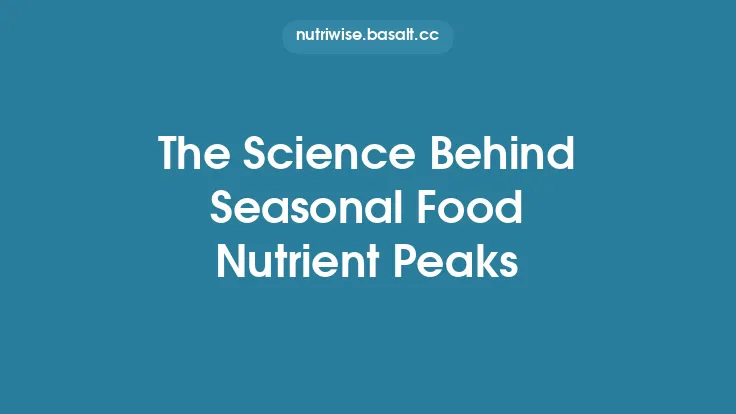Daily food rituals—those seemingly simple, repeatable actions that frame our meals—are more than cultural curiosities. When practiced consistently, they become powerful levers for long‑term health, influencing everything from hormone balance to the composition of the gut microbiome. By examining the underlying biology, we can see why a ritualized approach to eating often yields benefits that extend far beyond the plate.
The Neurobiology of Repeated Food Behaviors
Repeated actions engage the brain’s habit circuitry, principally the dorsolateral striatum and the basal ganglia. When a specific sequence—such as washing hands, arranging utensils, and then sitting down—occurs at the same time each day, dopaminergic signaling in the ventral tegmental area reinforces the pattern. Over weeks to months, the behavior transitions from goal‑directed (driven by hunger) to stimulus‑driven (triggered by contextual cues).
Key points:
- Cue‑Response‑Reward Loop – A consistent cue (e.g., the sound of a kitchen timer) initiates a neural cascade that predicts the reward of eating, priming the brain for efficient nutrient processing.
- Synaptic Plasticity – Long‑term potentiation (LTP) in the cortico‑striatal pathways consolidates the ritual, reducing the cognitive load required to initiate a meal. This frees mental resources for other tasks, indirectly supporting overall well‑being.
- Reduced Decision Fatigue – By automating the “what, when, and how” of eating, rituals diminish the need for daily deliberation, which has been linked to lower cortisol spikes and improved executive function.
Circadian Alignment and Metabolic Efficiency
Human metabolism follows a roughly 24‑hour rhythm orchestrated by the suprachiasmatic nucleus (SCN) in the hypothalamus. When meals are taken at irregular times, peripheral clocks in the liver, pancreas, and adipose tissue become desynchronized from the central clock, a state known as circadian misalignment. This misalignment is associated with impaired glucose tolerance, elevated triglycerides, and increased risk of metabolic syndrome.
Daily food rituals that anchor meals to consistent clock times—morning, midday, and evening—help:
- Synchronize Peripheral Oscillators – Regular nutrient influx entrains hepatic clock genes (e.g., *PER2, BMAL1*), optimizing gluconeogenesis and glycogen storage.
- Enhance Insulin Sensitivity – Predictable post‑prandial insulin peaks improve the responsiveness of insulin receptors, reducing the likelihood of chronic hyperinsulinemia.
- Promote Lipid Homeostasis – Timed lipid absorption aligns with the rhythmic expression of lipogenic enzymes, limiting ectopic fat deposition.
Importantly, the benefits arise from the regularity of the schedule rather than the specific macronutrient composition, making the principle broadly applicable across dietary patterns.
Microbiome Stability Through Predictable Dietary Patterns
The gut microbiota thrives on regularity. Sudden shifts in substrate availability (e.g., abrupt changes in fiber type or protein load) can cause transient dysbiosis, characterized by reduced microbial diversity and altered short‑chain fatty acid (SCFA) production. Daily food rituals that maintain a stable macronutrient and fiber profile foster:
- Consistent SCFA Production – Steady fermentation of complex carbohydrates yields acetate, propionate, and butyrate in predictable ratios, supporting colonic health and systemic anti‑inflammatory signaling.
- Resilient Microbial Networks – Repeated exposure to the same dietary niches encourages the growth of keystone species (e.g., *Faecalibacterium prausnitzii*), which act as ecological stabilizers.
- Reduced Pathobiont Overgrowth – Predictable nutrient flow limits the opportunistic expansion of opportunistic bacteria that flourish during periods of scarcity.
Long‑term, this microbial steadiness translates into improved barrier function, lower endotoxemia, and a more balanced immune tone.
Psychosocial Benefits of Shared Food Rituals
Beyond the physiological, daily food rituals often involve a social component—family members gathering, friends sharing a brief conversation, or coworkers convening for a brief break. These interactions trigger neurochemical cascades that reinforce health:
- Oxytocin Release – Physical proximity and eye contact during meals stimulate oxytocin secretion, which modulates stress pathways and promotes social bonding.
- Endogenous Opioid Activation – The pleasure derived from communal eating engages the brain’s reward system, enhancing mood and reducing perceived pain.
- Social Support Buffer – Regular shared meals create a predictable support network, which epidemiological studies link to lower incidence of depression and cardiovascular disease.
Even when the ritual is solitary, the act of “setting the stage” (lighting a candle, arranging plates) can simulate a sense of ceremony, providing similar psychological scaffolding.
Hormonal Regulation and Stress Mitigation
A predictable eating routine influences several endocrine axes:
- Hypothalamic‑Pituitary‑Adrenal (HPA) Axis – Anticipatory cues associated with a ritual reduce the acute cortisol surge that typically follows an unplanned meal, fostering a calmer post‑prandial state.
- Leptin and Ghrelin Dynamics – Regular meal timing stabilizes leptin (satiety hormone) and ghrelin (hunger hormone) rhythms, preventing the oscillations that can drive overeating.
- Thyroid Hormone Conversion – Consistent nutrient intake supports the peripheral conversion of T4 to T3, maintaining basal metabolic rate without the spikes associated with erratic feeding.
Collectively, these hormonal patterns contribute to a lower allostatic load—a key predictor of chronic disease risk.
Long‑Term Epigenetic and Immune Implications
Emerging research suggests that habitual dietary patterns can leave epigenetic marks on genes involved in metabolism and immunity. For instance:
- DNA Methylation of Metabolic Genes – Regular exposure to specific nutrients (e.g., omega‑3 fatty acids, polyphenols) can modulate methylation of *PPARγ* and *SREBP‑1c*, influencing lipid handling over years.
- Histone Acetylation in Immune Cells – Predictable intake of fermentable fibers promotes histone acetylation in regulatory T cells, enhancing their suppressive capacity and reducing chronic inflammation.
- MicroRNA Expression – Consistent meal timing has been linked to stable expression of microRNAs that regulate insulin signaling pathways, offering a molecular explanation for sustained insulin sensitivity.
These epigenetic adaptations are not fleeting; they can persist across decades, underscoring the profound impact of daily food rituals on lifelong health trajectories.
Designing Sustainable Daily Food Rituals
To translate these insights into practice, consider the following framework:
- Anchor to a Fixed Clock – Choose a specific time window for each main meal (e.g., 07:30 – 08:00 am). Use external cues like sunrise or a daily alarm to reinforce the schedule.
- Standardize Core Components – Identify a set of staple foods that provide balanced macronutrients and fiber. Rotate minor variations (seasonal vegetables, protein sources) to maintain nutritional adequacy while preserving predictability.
- Incorporate Sensory Cues – Consistent visual (plate color), auditory (soft music), or olfactory (a particular herb aroma) signals cue the brain that a meal is imminent, priming digestive enzymes.
- Allocate a Social Element – Even a brief 5‑minute conversation with a household member or a quick check‑in with a colleague can embed the ritual within a supportive network.
- Monitor and Adjust – Track subjective energy levels, sleep quality, and mood over weeks. Small tweaks—shifting the meal by 15 minutes or adding a probiotic‑rich food—can fine‑tune the system without breaking the overall pattern.
By keeping the ritual simple, repeatable, and enjoyable, adherence becomes almost automatic, allowing the underlying biology to do its work.
Future Directions in Research
While the current evidence base is robust, several gaps remain:
- Longitudinal Cohort Studies – Few studies have followed individuals for >10 years to directly link daily food ritual consistency with morbidity and mortality outcomes.
- Mechanistic Human Trials – Controlled experiments that isolate ritual cues (e.g., timing vs. sensory context) are needed to parse out the relative contributions of each component.
- Personalized Rhythm Mapping – Integrating wearable chronobiology data (core body temperature, melatonin onset) with dietary logs could enable individualized ritual schedules optimized for each person’s circadian phenotype.
- Microbiome‑Ritual Interactions – High‑resolution metagenomic analyses could clarify how specific ritual‑driven dietary patterns shape microbial gene expression over the long term.
Advancements in these areas will refine guidelines and potentially lead to prescription‑grade “ritual protocols” for preventive health.
In sum, daily food rituals act as a bridge between cultural tradition and modern science. By providing consistent cues that align neural, hormonal, and microbial systems, they create a physiological environment conducive to long‑term wellness. Embracing such rituals—grounded in regularity, sensory signaling, and modest social interaction—offers a pragmatic, evidence‑based pathway to healthier bodies and minds.





